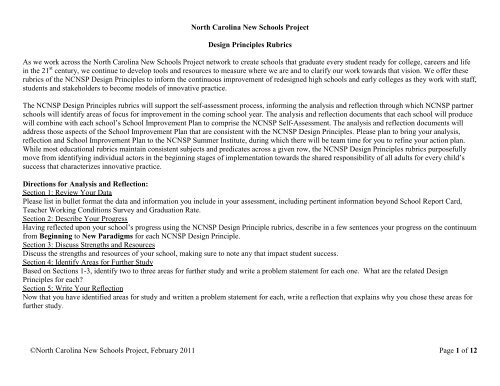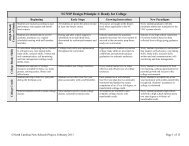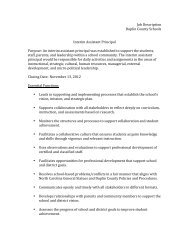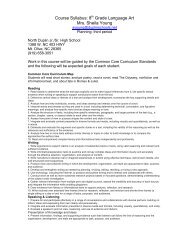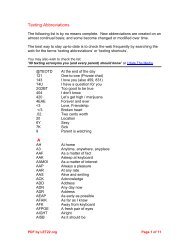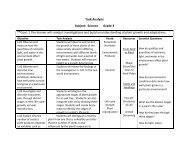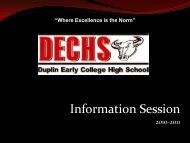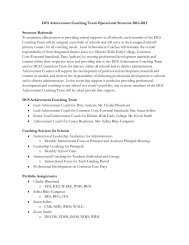North Carolina New Schools Project Design Principles Rubrics
North Carolina New Schools Project Design Principles Rubrics
North Carolina New Schools Project Design Principles Rubrics
Create successful ePaper yourself
Turn your PDF publications into a flip-book with our unique Google optimized e-Paper software.
Adult/Student RelationshipsNCNSP <strong>Design</strong> Principle 3: PersonalizationBeginning Early Steps Growing Innovation <strong>New</strong> ParadigmsA welcome letter is sent to incomingfreshmen.Some teachers meet occasionally todiscuss the needs and progress ofstudents.Staff members visit the homes ofincoming freshmen.There is a plan to develop a schoolschedule that provides time for teachersto meet at least once a week to discussthe needs and progress of students.Staff members visit the homes ofincoming freshmen and new students towelcome them and begin developingpositive relationships.All teachers meet weekly by grade levelor subject area to discuss the needs andprogress of students.Staff members visit the homes of everystudent annually in order to maintainpositive parent-school relationships anddiscuss the needs and progress ofstudents.Teachers are grouped by students andmeet during scheduled commonplanning times daily to discuss studentneeds and develop supports.Every student has a teacher-advisor.During informal conversations, studentsstate that they feel their teachers careabout them.Teacher-advisors meet with theirassigned students once a month.Data gathered from sources such asstudent surveys indicate that a majorityof students feel known and cared for bythe adults in their school.Teacher-advisors meet with theirassigned students weekly to review theiracademic progress.A school wide survey of the studentbody indicates that at least 95% ofstudents surveyed indicate that they feelknown, respected and cared for.Teacher-advisors meet with assignedstudents at least once a week to reviewtheir progress and provide academicand affective supports as needed.Teacher-advisors are looped to advancewith students as they advance throughhigh school and review the studentspersonal education plans in order toensure successful completion.Data from surveys of students andparents indicate that at least 98% ofboth populations feel that the adults inthe school care, know, and respectthem.The school distributes newsletters orother forms of communication toprovide updates and informationfrequently.School newsletters and communicationsare provided in a language other thanEnglish.School newsletters and communicationsare translated into every languagerepresented in the student population.The school website, blogs, tweets,social media sites and newsletters aretranslated into every languagerepresented in the school and are madeavailable. Parents, students and othercommunity members are also involvedin submitting information for thenewsletters and communications.©<strong>North</strong> <strong>Carolina</strong> <strong>New</strong> <strong>Schools</strong> <strong>Project</strong>, February 2011 Page 7 of 12
Shared Responsibility and CollaborativeDecision MakingCollaborative Work OrientationNCNSP <strong>Design</strong> Principle 4: Redefine ProfessionalismBeginning Early Steps Growing Innovations <strong>New</strong> ParadigmsPrincipals observe teachers.Staff attends staff meetings and/orcommon planning opportunities, asappropriate.Teachers work independently.School implements district protocolsfor recruitment, interview and hiringprocesses.Teachers supervise advisories.Students are organized into advisorygroups and/or project teams.Professional development opportunitiesare offered to support youthdevelopment.Principals make decisions related toschool-wide issues and teachers makedecisions related to classroom issues.Teachers observe their peers inpractice.Staff meetings and/or commonplanning opportunities modelcollaboration among adults.Staff collaborates with peers and, attimes, share expertise for professionallearning and improved practice.Principal includes one or more staff inrecruitment, interview, and hiringprocesses for their specific school.Teachers are developed as teachercounselorsthrough a common researchbased approach to student development.Peer connections are promoted throughadvisory groups and/or project teamsTeachers share strategies for engagingchallenging students.Staff has some input into schooldecisions, including the selection ofrepresentatives to decision-makingbodies.Teachers observe their peers in practicefor the purpose of giving and receivingfeedback for revision and improvement.Staff meetings and/or commonplanning opportunities model inquiryamong adults.Staff regularly collaborates with peers,share expertise, and holds themselvesaccountable for professional learningand improved practice.Principal and staff collaborate onrecruitment, interview, and hiringprocesses to ensure alignment with theschool’s mission.Teachers lead advisories that provideconsistent guidance and support,including the development of personallearning plans and support foremotional, social and academic needs.Students have an overt and clearlydelineated mechanism for participatingin student development and schoolsuccess.Teachers collaboratively create flexiblesolutions for engaging challengingstudents.All staff work together to makedecisions that advance the mission ofthe school.All staff members solicit peer feedbackin order to advance their own practice.Staff is engaged in inquiry around theirpractice through sharing their work,student work and professionaldilemmas for feedback and support.Staff regularly collaborates with peers,share expertise, and hold themselvesand peers accountable for professionallearning and improved practice.Staff, parents, and students collaborateon recruitment, interview and hiringprocesses to ensure alignment with theschool’s mission.All adults in the school assumeresponsibility for youth developmentand each student’s success.Students assume responsibility forpositive school and communityengagement that contributes tocitizenship.The school actively engages familiesregarding successes and challenges thattheir child faces and works withfamilies to arrive at successfulsolutions.Individuals from all constituent groupsare engaged in and can clearlyarticulate the school decision-makingprocess and the avenues forparticipation.©<strong>North</strong> <strong>Carolina</strong> <strong>New</strong> <strong>Schools</strong> <strong>Project</strong>, February 2011 Page 8 of 12
SustainabilityNCNSP <strong>Design</strong> Principle 4: Redefine ProfessionalismBeginning Early Steps Growing Innovations <strong>New</strong> ParadigmsKnowledge Capture & ExchangeStaff maintains personal classroom andinstructional resources and units ofstudy.NetworkingAssigned teachers participate inscheduled NCNSP network events.All staff share resources and units ofstudy with school-based peers.Teachers initiate participation inscheduled NCNSP network events.All staff post and use resources andunits of study in a shared best-practicelibrary.Staff participates in peer networks forthe purpose of giving and receivingfeedback to advance specific practices.All staff routinely vets individual andshared resources and units of studyposted in a shared best-practice librarywith school-based peers and with peersacross the NCNSP network.Staff convene and regularly networkwith peers, employers, and expertsbeyond the school.CommunicationStaff members sometimes speak insupport of the school with internal andexternal stakeholders.Staff members routinely speak insupport of the school with internal andexternal stakeholders.Staff members speak with confidenceabout collectively made decisions withinternal and external stakeholders.Staff members speak with confidenceto stakeholders about collectively madedecisions and their alignment with theschool’s mission and vision.Capacity BuildingSchool participates in NCNSP-providedprofessional development.<strong>Schools</strong> have a mechanism fordisseminating resources and materialsgarnered from NCNSP professionaldevelopment experiences.<strong>Schools</strong> secure resources andprofessional development experiencesaligned with the school’s mission andvision and NCNSP <strong>Design</strong> <strong>Principles</strong>.<strong>Schools</strong> have a systematic, internalprocess for the on-boarding anddevelopment of new staff and crosstraining,capacity building, andcontinued acculturation of existing staffaligned with NCNSP <strong>Design</strong> <strong>Principles</strong>.©<strong>North</strong> <strong>Carolina</strong> <strong>New</strong> <strong>Schools</strong> <strong>Project</strong>, February 2011 Page 9 of 12
Autonomous GovernanceNCNSP <strong>Design</strong> Principle 5: Purposeful <strong>Design</strong>Beginning Early Steps Growing Innovations <strong>New</strong> ParadigmsA full-time principal has been namedand essential staff has been hired.The school has a unique school codeand a preliminary school budget hasbeen prepared.The school has established an identityand theme.The district office is aware of theseparate professional developmentrequirements set forth by the NCNSP.Adequate instructional and support staffmembers have been hired. Along withthe principal, their time is not dividedwith other schools.The principal and staff meet to reviewand discuss the school budget.The school actively advertises theirschool’s identity and theme and visitsmiddle schools to recruit their targetpopulation.The district office has waived requiredattendance at some of the district levelprofessional development.The principal, instructional staff, andsupport staff meet consistently todiscuss scheduling and hiring decisionsas well as other school operation itemsin order to make decisions that will bestmeet students’ needs. The principaland staff members have significantautonomy from undesirable stafftransfers and district level professionaldevelopment mandates.The principal and staff meet frequentlyto discuss the school budget and makerevisions as necessary.The school is autonomous in makingdecisions regarding curriculumdecisions as related to the school’sidentity and theme.The district office and the schoolpartner are involved in the decisionmaking process regarding theattendance of the principal and staff forselected professional developmentevents.The principal and staff members workas a team in which distributedleadership is used and everyone isactively involved in key areas ofdecision making. The principal andstaff meet during scheduled, specifictimes at least once a week and use theirautonomy from district mandates tomake decisions and solve problems tocreate unique instructional designs tomeet student needs.The principal and staff meet on ascheduled basis to review the schoolbudget and make any necessaryrevisions. The budget is revised asnecessary to make decisions thatexemplify a flexible use of resources inthe best interests of students.The school reaches out to local, state,national and global organizations in todeepen the connection between theschool’s identity, theme, and real worldapplications.The principal and staff have completeautonomy in making decisionsregarding attendance at district levelprofessional development events. Theprincipal and staff attend andimplement all NCNSP mandatedprofessional development. They alsowork together to identify and developany additional professionaldevelopment needed.©<strong>North</strong> <strong>Carolina</strong> <strong>New</strong> <strong>Schools</strong> <strong>Project</strong>, February 2011 Page 10 of 12
Student Recruitment andSelection*School SustainabilityNCNSP <strong>Design</strong> Principle 5: Purposeful <strong>Design</strong>Beginning Early Steps Growing Innovations <strong>New</strong> ParadigmsThere is a detailed budget plan onefiscal year prior to the current fiscalyear.The school is recognized in thecommunity.The school is well recognized by theschool district and local educationpartners.Recruitment materials for the schoolare available.A school admissions policy exists.The principal recruits in middleschools.There is a detailed five year budgetplan for the duration of initial funding.The school fosters relationships withbusiness and community partners forfinancial support, community serviceopportunities, job shadowingopportunities and participation inschool projects during the school year.The school has scheduled meetingswith the school district and highereducation partner to discusssustainability of the school.Recruitment materials are aligned withNCNSP guidelines for the specificmodel.The school admissions policy is welldefined and non-selective.The principal and staff recruit in middleschools.There is a detailed budget plan toensure program sustainability beyondinitial funding.The school develops business andcommunity partnerships for continuousfinancial support, community serviceopportunities, internship opportunities,and participation in school projects thatconnect to and influence decisionmaking.Short and long range plans fordevelopment and sustainability of theschool are available and supported bythe school district and higher educationpartner.Recruitment materials are aligned withNCNSP guidelines for the specificmodel in at least two languages.Some faculty members participateduring middle school recruitment visitsand presentations. The staffparticipates during the selectionprocess. A rubric for targetedrecruitment focused on the designprinciples is implemented.The principal, staff and studentsexplicitly reach out to underrepresentedparent and community groups.There is a detailed budget plan toensure program sustainability beyondinitial funding that incorporatesbusiness and community partnersupport as well as other stakeholders.The school develops business andcommunity partnerships for ongoingfinancial support, community serviceopportunities and participation inschool projects that connect to andinfluence decision making. Businessand community partners are also usedto provide opportunities that connectstudents to real world learningexperiences.A plan for the sustainability of theschool is embedded within the outlookof the school district and highereducation partner.Recruitment materials aligned withNCNSP guidelines for the specificmodel are available online in multiplelanguages.Faculty, staff, students and communityleaders assist the principal byparticipating during the selectionprocess. A rubric for targetedrecruitment and student interviews areused in the process.A community approach involving thestaff, parents, students, civic leadersand business leaders is executed toreach out to underrepresented parentand community groups.©<strong>North</strong> <strong>Carolina</strong> <strong>New</strong> <strong>Schools</strong> <strong>Project</strong>, February 2011 Page 11 of 12
CollaborativeWorkOrientationNCNSP <strong>Design</strong> Principle 5: Purposeful <strong>Design</strong>Beginning Early Steps Growing Innovations <strong>New</strong> ParadigmsTeachers work independently.Staff members collaborate with peersand, at times, share expertise forprofessional learning and improvedpractice.Staff regularly collaborates with peers,share expertise, and holds themselvesaccountable for professional learningand improved practice. A commonplanning time has been established aspart of the master schedule.Staff regularly collaborates with peers,shares expertise, and holds itself andpeers accountable for professionallearning and improved practice.©<strong>North</strong> <strong>Carolina</strong> <strong>New</strong> <strong>Schools</strong> <strong>Project</strong>, February 2011 Page 12 of 12


